It’s possible that I shall make an ass of myself. But in that case one can always get out of it with a little dialectic. I have, of course, so worded my proposition as to be right either way (K.Marx, Letter to F.Engels on the Indian Mutiny)
Saturday, January 22, 2022
Claude Guéant went on trial over accusations of misusing public money for opinion polls
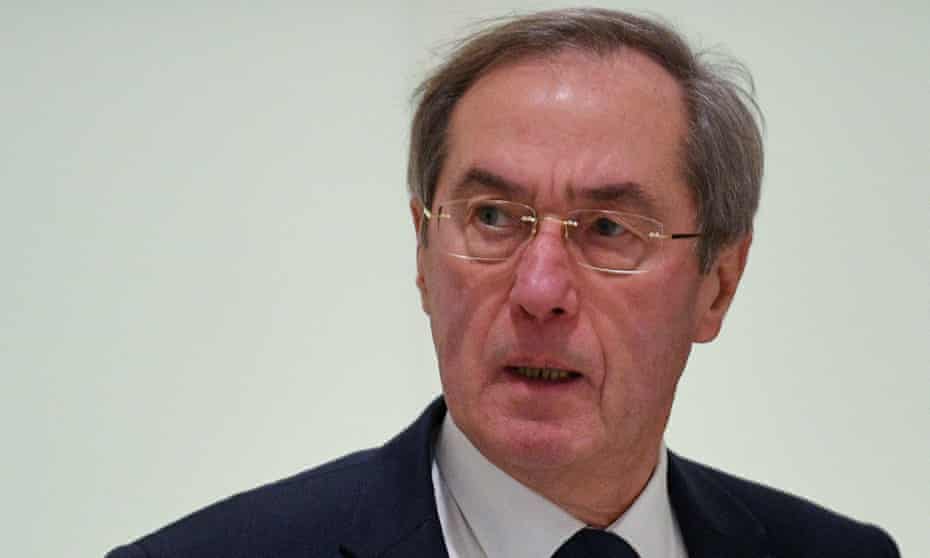
AFP in Paris
Fri 21 Jan 2022
The former chief of staff of the ex-French president Nicolas Sarkozy was handed a new jail sentence Friday, adding to a long list of convictions stemming from the rightwinger’s 2007-2012 term in office.
Claude Guéant, considered one of Sarkozy’s closest confidants, went on trial in October along with four other aides and allies over accusations they misused public money while ordering public opinion polls worth a combined €7.5m (£6.3m).
Guéant, who is already in jail over a separate offence, was handed a one-year prison sentence by a court in Paris on Friday, with a requirement to serve a minimum of eight months.
The writer and one-time Sarkozy adviser Patrick Buisson was handed a two-year suspended sentence and a €150,000 fine, while the former cabinet director Emmanuelle Mignon was given a six-month suspended sentence.
The former pollster and consultant Pierre Giacometti was also convicted and handed a six-month suspended sentence and a fine of €70,000.
They were accused of ordering polls for Sarkozy in secret and without competition, breaking French laws on public financing that require transparency and competitive bidding.
The former Sarkozy aide Julien Vaulpré was the only one of the five accused to be cleared.

Nicolas Sarkozy ordered to testify in former aides’ trial
Sarkozy was not targeted directly and had refused to testify as a witness until compelled to do so by a judge.
In September last year, a separate court handed Sarkozy a one-year prison sentence for illegal financing of his 2012 re-election bid, seven months after he received a jail term for corruption.
The 66-year-old, who is appealing against both of those convictions, has also been charged over suspicions he received millions of euros for his 2007 election campaign from the late Libyan dictator Muammar Gaddafi.
Guéant, 77, was jailed in December after he was found to have failed to pay a fine and damages to the state relating to a previous sentence, handed down in 2017, for operating a suspected slush fund.
He immediately announced an appeal against Friday’s sentence.

The military junta toppled Aung San Suu Kyi's government in 2021 (AFP/STR)
Fri, January 21, 2022
The exit of energy titans TotalEnergies and Chevron from Myanmar's billion dollar gas industry has been hailed by rights groups, but analysts say it will not significantly weaken the generals and may even enrich the military in the short term.
Both firms had faced pressure to cut financial links with the junta that toppled Aung San Suu Kyi's government last year and has since killed more than 1,400 people in a crackdown on dissent, according to a monitoring group.
The French firm and US oil major Chevron will withdraw from the Yadana gas field in the Andaman Sea, which provides electricity to the local Burmese and Thai population.
Myanmar's gas industry -- which Human Rights Watch says generates $1 billion a year -- has so far evaded swingeing sanctions imposed by the United States and EU on lucrative military-owned timber and jade enterprises.
Friday's "announcement is certainly significant," Manny Maung, Myanmar researcher at Human Rights Watch told AFP.
"But there is a lot more pressure needed to defeat this junta for good.
"Governments no longer have an excuse to delay imposing targeted sanctions on oil and gas entities... to prevent any other unscrupulous entities from entering the market."
TotalEnergies and Chevron's departure will deprive the junta of hundreds of millions of dollars a year in foreign revenue as the economy it presides over tanks from months of unrest and a mass walkout.
TotalEnergies alone paid around $176 million to Myanmar authorities in 2020 in the form of taxes and "production rights", according to the company's own financial statements.
Naw Susanna Hla Hla Soe, a minister in a shadow government dominated by lawmakers from Suu Kyi's party which is working to topple the military said the news sent a "very strong message" to the junta.
"Other companies must follow Total's example to put even more pressure on the generals," she added.
- 'No confidence' -
If the French and American titans were willing -- belatedly -- to bow to rights groups and activist pressure, there are others with fewer qualms about making money in junta-run Myanmar.
"It will be harder to force the hand of Asian investors because their human rights commitments and the stakeholder pressures on them are lower," Dr Htwe Htwe Thein at Curtin University in Australia, told AFP.
Others say it is possible the junta will profit short-term from any change in ownership.
The withdrawal of TotalEnergies is "a big vote of no confidence in the regime", International Crisis Group's Myanmar senior advisor Richard Horsey told AFP.
But the junta would likely be able to "sell the departing operators' stakes", he added -- which would inject much needed hard currency into the state coffers.
The military would also be able to "attract and negotiate favourable terms and signature payments from operators in jurisdictions beyond the scope of Western sanctions".
TotalEnergies will not exit immediately -- it said in a statement it will continue to operate the site for the next six months at the latest until its contractual period ends.
"As things stand... Means likely cash windfall for the regime unless ways are found to prevent that, which must be priority," Horsey said on Twitter.
And the generals' economic portfolio stretches far beyond gas, and includes interests in mines, banks, agriculture and tourism, providing the military with a colossal -- and closely guarded -- fortune.
The jade industry alone -- dominated by military-owned business -- provides the military with billions of dollars a year in off-the-books revenue, analysts say.
There also remains the question of how easy TotalEnergies and Chevron will find it to exit junta-ruled Myanmar, said Htwe Htwe Thein, citing Norway's Telenor, which announced it was withdrawing in July, but whose exit has been held up by the military.
"Total may suffer the same fate," she said.
bur-rma/je
Oil majors TotalEnergies and Chevron withdraw from Myanmar
By Benjamin Mallet and Florence Tan
PARIS (Reuters) -Oil majors TotalEnergies and Chevron Corp, partners in a major gas project in Myanmar, said on Friday they were withdrawing from the country, citing the worsening humanitarian situation following last year's coup.
Royal Dutch Shell Plc, in its first public acknowledgment of the move, also said on Friday that it no longer held exploration licences in Myanmar as of last year.
Myanmar has been in turmoil since the army overthrew the elected government in February 2021 and detained its leader Aung San Suu Kyi. The junta has used brutal force https://www.reuters.com/world/asia-pacific/death-toll-since-myanmar-coup-tops-1000-says-activist-group-2021-08-18 to put down protests.
TotalEnergies and Chevron, along with other firms, were part of a joint venture operating the Yadana gas project off Myanmar's southwestern coast, and the MGTC transportation system carrying gas from the field to the Myanmar/Thailand border.
They have now become the latest Western companies to decide to pull out in the wake of the coup.
"The situation, in terms of human rights and more generally the rule of law, which have kept worsening in Myanmar since the coup of February 2021, has led us to reassess the situation," TotalEnergies said in a statement.
"As a result, (it) has decided to initiate the contractual process of withdrawing from the Yadana field and from MGTC in Myanmar, both as operator and as shareholder, without any financial compensation for TotalEnergies."
A spokesperson later added that despite civil resistance movements, "the junta is settled in power and our analysis is that, unfortunately, it is there to stay."
Since the coup, Myanmar security forces have killed more than 1,400 people and arrested thousands, local non-governmental organisation Assistance Association for Political Prisoners said. The junta disputes the figures.
TotalEnergies did not quantify the financial impact of the withdrawal, but said Myanmar represented a minor part of its revenue.
"Financial considerations have never been crucial in this matter. Our operations in Myanmar amounted to $105 million in 2021, equivalent to less than 1% of the company's income," said the TotalEnergies spokesperson.
Myanmar amounted to 0.6% of TotalEnergies' total oil and gas production in that period.
A Chevron spokesperson said: "In light of circumstances in Myanmar, we have reviewed our interest in the Yadana natural gas project to enable a planned and orderly transition that will lead to an exit from the country."
"As a non-operator with a minority interest in the project, our immediate priority remains the safety and well-being of employees, safe operations and the supply of much-needed energy for the people of Myanmar and Thailand."
Total was the biggest shareholder in the project with a 31.24% stake, while Chevron holds 28%. PTTEP, a unit of Thai national energy company PTT, and Myanmar state-owned oil and gas group Myanmar Oil and Gas Enterprise (MOGE) hold the remainder.
Shell, an equity holder in offshore Block A7 with partners Woodside Energy and Myanmar Petroleum Exploration and Production Co, said it had relinquished its exploration licences in Myanmar last year.
"Exploration blocks have been relinquished, therefore there is no production, revenue nor related payment to government," a spokesperson told Reuters.
SANCTIONS?
Rights groups welcomed TotalEnergies' move and said more companies - and sanctions https://www.reuters.com/business/media-telecom/un-rights-chief-urges-asean-move-myanmar-dialogue-2021-07-07 on Myanmar's oil and gas - should follow.
"TotalEnergies has finally taken heed of the calls of Myanmar people, local and international civil society to stop the flow of funds to the terrorist junta," said Yadanar Maung, a spokesperson for activist group Justice for Myanmar.
"It is now essential that international governments move ahead with targeted sanctions on oil and gas to deny the junta funds from the remaining oil and gas projects."
TotalEnergies said that before deciding to pull out of Myanmar, it had been in a dialogue with French and U.S. authorities for months to consider putting in place targeted sanctions that would confine financial flows to escrow accounts without shutting down gas production.
"TotalEnergies has not identified any means for doing so," it said.
Total and Chevron last year suspended some payments from the project that would have reached the junta, earning some praise from pro-democracy activists.
The group said it had notified its partners in Myanmar of its withdrawal, which will become effective at the latest at the expiry of a six-month contractual period.
Located in the Gulf of Martaban, the Yadana field produces around 6 billion cubic metres per year of gas, about 30% of which is supplied to MOGE for domestic use and 70% exported to Thailand.
"This gas helps to provide about half of the electricity in the Burmese capital Yangoon and supplies the western part of Thailand," TotalEnergies said.
The spokesperson for TotalEnergies said PTT would be a 'natural' choice for its Myanmar assets, adding it was already in contact with the company over this. PTT unit PTTEP said it was "carefully considering" what to do next.
The military-run Myanmar government did not immediately respond to a request for comment. MOGE officials declined to comment.
TotalEnergies told Reuters the withdrawal process did not require the approval of Myanmar authorities.
(Reporting by Sudip Kar-Gupta, Benjamin Mallet in Paris, Florence Tan in Singapore and Chayut Setboonsarng in BangkokWriting by Ingrid Melander and Gwladys Fouche; Editing by David Goodman, Jan Harvey and Matthew Lewis)



This photograph released by the Myanmar’s Military Information Team shows former lawmaker Maung Kyaw -- also known as Phyo Zeyar Thaw -- who had been accused of orchestrating attacks on regime forces (AFP/-)
Fri, January 21, 2022, 10:10 AM·3 min read
A Myanmar military tribunal sentenced a member of Aung San Suu Kyi's ousted party to death for terror offences on Friday, the junta said, ramping up a crackdown on the toppled leader's party.
The Southeast Asian country has been in chaos since the February coup, with more than 1,400 killed in a subsequent crackdown on dissent, according to a local monitoring group.
Junta opponents -- including allies of Suu Kyi's National League for Democracy -- have gone into hiding across the country, and "People's Defence Forces" have sprung up across the country to take on the military.
Phyo Zeyar Thaw, a member of the NLD arrested in November, was sentenced to death for offences under the anti-terrorism act, the junta statement said.
Prominent democracy activist Kyaw Min Yu -- better known as "Jimmy" -- received the same sentence from the military tribunal, the statement added, carrying pictures of both men.
Their sentences were also read out on state media's nightly news.
The junta has sentenced dozens of anti-coup activists to death as part of its crackdown on dissent but Myanmar has not carried out an execution for decades.
- 'Tip off' -
Phyo Zeyar Thaw -- whose real name is Maung Kyaw -- was arrested at an apartment in the commercial hub Yangon following a "tip-off and cooperation from dutiful citizens," according to the junta.
The former lawmaker -- who also goes by the name Phyo Zeyar Thaw -- was in possession of two pistols, ammunition and an M-16 rifle, it said at the time.
He had been accused of orchestrating several attacks on regime forces, including the brazen shooting on a commuter train in Yangon in August that killed five policemen.
A hip-hop pioneer in Myanmar whose subversive rhymes irked the previous junta, he was jailed in 2008 for membership in an illegal organisation and possession of foreign currency.
He was elected to parliament from Suu Kyi's NLD in the 2015 elections that ushered in a transition to civilian rule.
Kyaw Min Yu, who rose to prominence during Myanmar's 1988 student uprising was arrested in an overnight raid in October.
Part of the so-called 88 Generation movement that challenged Myanmar's previous military government, the junta issued an arrest warrant for him last year, alleging he had incited unrest with his social media posts.
Suu Kyi is facing a raft of criminal and corruption charges -- including violating the country's official secrets laws -- and if convicted of all of them could face sentences tallying more than 100 years of prison.
She has already been sentenced to six years for illegally importing and possessing walkie-talkies, flouting Covid rules and incitement against the military.
Before the coup, she was on the cusp of beginning another five-year term as the country's de facto leader after the NLD won a landslide in November 2020 polls.
Since the coup, many of her political allies have been arrested, with one chief minister sentenced to 75 years in jail.
bur-rma/bgs
Friday, January 21, 2022
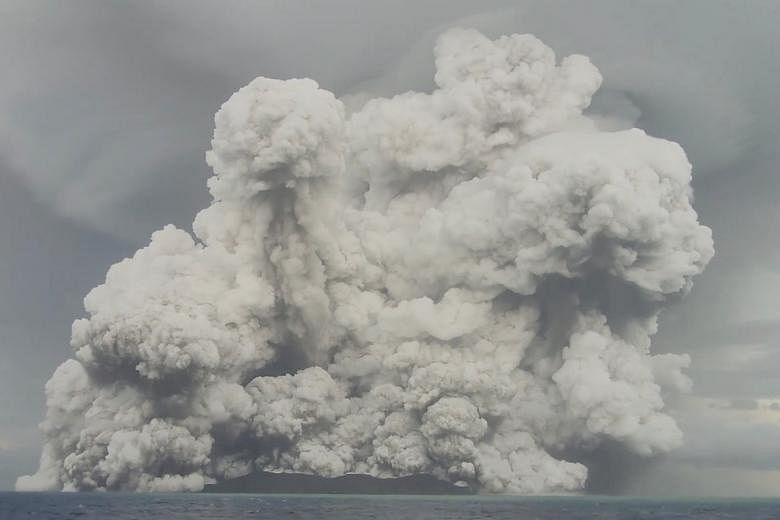
SYDNEY (REUTERS) - Mr Branko Sugar and his son were spearfishing on an outer reef in Tonga last Saturday (Jan 15).
The air smelt of sulphur, as it had done for weeks, from the nearby active volcano, but he noticed the ash cloud from the crater was much higher.
As the 61-year-old stowed away his spearfishing gear, the first of four loud volcanic explosions rocked the tranquil South Pacific, sending a giant wave towards his boat.
"We stopped the boat and just looked. Then we saw the wave coming towards us. The biggest wave I've ever seen," Mr Sugar told Reuters via telephone from Tonga on Friday where communications are still only being restored.
Mr Sugar turned his boat, a 400-horsepower 27-foot (8m) World Cat catamaran, and accelerated towards deep water near Eueiki Island.
"That's what saved us, the power of the boat," he said. "I shouldn't be alive."
As he raced for safety, Mr Sugar telephoned his home on Tonga's main island Tongatapu to warn of the approaching tsunami, but nobody answered.
"The wave came past us and hit the main island, and then we knew we'd managed to get away. But then the rocks started raining. It was raining stones," he recalled.
In minutes, the Pacific blue sky turned to total darkness, ash enveloped everything and a storm seemed to whip up, lashing the boat with wind and waves.
A 12-mile (19km) trip home took three hours in the darkness before they reached the harbour.
"There were wrecked boats everywhere. Upside-down boats, sunken boats. We didn't know where to go," Mr Sugar said.
"And when we finally stopped, then we couldn't find our cars - they'd all been swept away. It was one thing after another. When we finally found them, I couldn't drive, I was blind from rocks pounding my eyes for hours driving the boat."
The Hunga Tonga-Hunga Ha'apai volcano eruption triggered tsunami that destroyed villages, resorts and many buildings and knocked out communications for the nation of about 105,000 people. It also sent shockwaves and tsunami across the Pacific.
Three people have been reported killed, say Tongan authorities.
Nasa's Goddard Space Flight Centre has said the force of the eruption was estimated to be the equivalent of five to 10 megatons of TNT, or more than 500 times that of the nuclear bomb the United States dropped on the Japanese city of Hiroshima at the end of World War II.
For many years, the Hunga Tonga-Hunga Ha'apai volcano poked above the waves as a pair of narrow rocky isles, one named Hunga Tong and the other Hunga Ha'apai. An eruption in 2014 built up a third island that later connected the trio into one landmass. And when the volcano awoke in December, the uninhabited island at the peak's tip slowly grew as bits of volcanic rock and ash built up new land.

Then came the catastrophic eruption on January 15. As seen in satellite images, only two tiny outcrops of rock now betray the beast lurking beneath the waves. But whether it happens in weeks or years, the volcano will rise again.
This cycle of destruction and rebirth is the lifeblood of volcanoes like Hunga Tonga-Hunga Ha'apai, which is just one of many that dot the Kingdom of Tonga. Still, the tremendous energy of this latest explosion, which NASA estimated to be equivalent to five to six million tons of TNT, is unlike any seen in recent decades. The eruption sent a tsunami racing across the Pacific Ocean. It unleashed a sonic boom that zipped around the world twice. It sent a plume of ash and gas shooting into the stratosphere some 19 miles high, with some parts reaching as far as 34 miles up. And perhaps most remarkable, all these effects came from only an hour or so of volcanic fury.

"Everything so far about this eruption is off-the-scale weird," says Janine Krippner, a volcanologist with Smithsonian's Global Volcanism Program.

Scientists are now racing to work out the cause behind this week’s intense outburst and the surprisingly widespread tsunamis that followed. Some clues to what set the stage for such a powerful explosion may come from the chemistry of rocks that cooled from lava in past eruptions. In a new study published in the journal Lithos, scientists found key differences between the erupted material of small and large blasts—and now they are curious what the chemistry of this latest event might reveal.
Understanding the spark that ignited Hunga Tonga-Hunga Ha'apai’s recent explosive event could help reduce future risks. For now, however, the biggest concern is for the people of Tonga, and whether there could be more volcanic outbursts on the horizon. Almost all of the volcano is now beneath the ocean surface, hidden from satellite view, and there's no equipment on the ground to help track subterranean shifts of molten rock

"If we can't detect what is happening in the magma system, we have no idea what might happen next," Krippner says.
An underwater giant
While Hunga Tonga-Hunga Ha'apai has erupted many times in the past, scientists only recently realized how large these eruptions could be. Mostly submerged underwater, the volcano is not easy to study.
"No one had actually done any work on the rocks," says Simon Barker, a volcanologist at Victoria University of Wellington in New Zealand and an author of the new Lithos study documenting the volcano's history.
Barker and his colleagues chartered a boat in 2015 to camp for several nights on the volcanic island’s rubbly landscape. As they surveyed the region and collected samples of rock, the team spotted small cones from recent eruptions dotting the seafloor around the primary peak. They also discovered thick layers of fragmented lava rocks and ash, known as pyroclastic flows, from two monstrous eruptions that they later dated to around 900 and 1,800 years old.
"We saw there was a lot more complexity to the history of the volcano," Barker says.
The chemistry of erupted material might help untangle what made this eruption so powerful, explains Marco Brenna, a volcanologist at the University of Otago in New Zealand and an author of the new Lithos study.
As a magma system cools, crystals of different minerals form at different times, which changes the chemistry of the dwindling molten rock. The crystals preserve these changes as they grow, a little like tree rings.
Brenna and his colleagues analyzed the rings of crystals in the rocks that erupted during the two large blasts 900 and 1,800 years ago. Their work suggests that before the volcano unleashed these eruptions, fresh magma was rapidly injected into the chamber—a commonly proposed trigger for many volcanic eruptions. But the rocks from more moderate explosions in 2008 and 2015 lacked these rings, pointing to a constant but slow influx of magma, Brenna says.
Scientists are now hoping to study the chemistry of the freshly erupted rock to see what it can tell us about this latest event. "It'll be interesting to see what the crystals are recording," Brenna says.
While these subterranean processes may be driving part of the explosivity, water also likely had a hand in this weekend's blasts, says Geoff Kilgour, a volcanologist with New Zealand's GNS Science who was not part of the study team. Water can supercharge the power of a volcanic explosion, but it remains unclear exactly how it would have sparked the astounding boom from Hunga Tonga-Hunga Ha'apai.
Perhaps, Kilgour suggests, the recent explosion had just the right mix of magma and water; an excess of either one would have generated a more moderate blast. "It may be that we've gotten to this Goldilocks zone," he says.
Airblast tsunami?
This latest eruption is layering on even more intrigue because its mighty boom, while energetic, ejected surprisingly little material. Ash from the volcano's past large eruptions can be found on the nearby island of Tongatapu, and that layer is 10 times thicker than the new layer deposited there by the recent event, Barker says.
Some scientists now speculate that the enormous, short-lived burst of energy may have helped stir up the unusually large tsunami waves that followed the eruption.
Tsunamis usually radiate from a sudden underwater shift, like a submarine landslide down a volcano's flanks or rapid movement of the land in an earthquake. Yet after Hunga Tonga-Hunga Ha'apai erupted, waves appeared in some places, such as the Caribbean, far earlier than would be expected of a classic tsunami.
The later tsunami waves that crashed on distant shores were also strange. The farther from the trigger a tsunami travels, the more its waves should diminish. While the waves that hit the islands in the Kingdom of Tonga were damaging, they weren't high enough to account for the surprisingly large waves across the ocean.
"It basically had a very low decay of tsunami size all around the Pacific, which is really, really unusual," Kilgour says. The shockwave that traveled through the air could have coupled with the sea surface, driving the expansive tsunamis. Just such a process was proposed for the 1883 explosion of Krakatoa, one of the most powerful and deadly volcanic eruptions in recorded history.
Modeling the spread and timing of the waves along with mapping changes to the volcano could help explain what drove the large tsunami. Still, Krippner says, the confusing mix of events "is going to change the way we look at this style of eruption—and that doesn't happen that often."
Trying to monitor a hidden giant
The recent event and all its oddities highlight how little is known about submarine volcanoes, says Jackie Caplan-Auerbach, a seismologist with Western Washington University. Many of these submerged giants linger in the deep ocean, and their blasts usually aren't deadly. Yet this weekend's explosion is a stark reminder of the risks of volcanoes lingering just beneath the waves.
For now, Hunga Tonga-Hunga Ha'apai seems to have fallen silent. The locals are helping each other pick through the damage and clean up the streets. While communications remain largely severed, information about the current situation is finally starting to trickle out. Three deaths have been confirmed among Tonga's residents, with two additional deaths in Peru from the tsunami.
Damage on some of the islands is severe. The homes of all 36 residents of Mango Island have been destroyed. Just two houses still stand on Fonoifua Island, and extensive damage stretches across Nomuka Island, which has a population of 239. Damage to the largest and most populous island, Tongatapu, where about 75,000 people live, was mostly focused on the western side. The Tonga Red Cross estimates a total of 1,200 "affected households."
Ash has contaminated the islands' stores of drinking water and delayed planes from landing with additional supplies. The New Zealand navy has deployed two supply ships that are scheduled to arrive on January 21.
And there's still a risk that the volcano could have more explosive blasts in store. The Tonga Geological Services relies on visual and satellite observations to track the activity of the many volcanoes across the region. But with Hunga Tonga-Hunga Ha'apai’s volcanic tip now beneath the surface, scientists have lost sight of any signs that might help understand the volcano's activity. The potential for additional activity also prevents scientists from flying nearby for a closer look.
Even when the volcano isn't actively erupting, monitoring largely submarine volcanoes is a complex task. GPS—which is frequently used to track shifts in the surface as magma moves underground—doesn't work on the seafloor. And obtaining real-time data from seismometers on the ocean floor is technologically difficult and expensive. Caplan-Auerbach says she often likens working in the oceans to doing seismology on another planet.
Instruments known as hydrophones can listen to the grumbles of submarine volcanoes as the sound travels across vast tracts of the ocean. But these are not easy to deploy in emergency situations and require connection to underwater cables for real-time data.
The situation in Tonga highlights the need for better international efforts to fund volcano monitoring around the world, Krippner says. She and other volcanologists have all stressed how well the Tonga Geological Services is handling a near-impossible task. "They don't have a huge amount of money. They don't have a huge amount of staff," Kilgour says. "But they're asked to do a huge amount."
In the days leading up to the January 15 blast, based on visual and satellite information alone, the agency persistently warned of future eruptions and a potential tsunami, instructing locals to stay away from the beaches. "Because of that, I think they saved probably thousands of lives," Barker says.
"We often learn from these really dreadful times," Caplan-Aurbach adds. Perhaps by closely studying the aftermath of this volcanic explosion, "we'll have a better sense for what's coming."
BANGKOK (AP) — As the massive undersea Hunga Tonga Hunga Ha’apai volcano erupted on Saturday, Tongans from around the world gazed on as their relatives livestreamed images of billowing clouds of ash, gas and steam emerging from beneath the depths

Then darkness.
The eruption severed Tonga's single fiber-optic cable, rendering the entire Pacific archipelago offline and unable to communicate with the rest of the world — and leaving their loved ones terrified about what might have happened.
“It was absolutely crazy,” said Koniseti Liutai, a Tongan who lives in Australia.
“We were talking with family and relatives, because they were excitedly showing us the volcano's activities, then we heard the explosion and the big bang and everything went dark,” he said. “Then the next information we got was the tsunami warning and then the tsunami hitting; we were all absolutely fearing the worst.”
It wasn't only family and friends who could not get through. Huge ash clouds made backup communication by satellite phone next to impossible, and world leaders were not even able to get in touch with their Tongan counterparts to see what help they needed.
As the ash cleared, satellite communication improved and Tonga's telecoms operator, Digicel, said it had been able to restore international call services to some areas late Wednesday.
It cautioned, however, that due to the high number of calls and the limited capacity of its satellite link that people may need to try repeatedly to get through — something experienced by Liutai, who is deputy president of the Tonga Australia Chamber of Commerce.
“My first direct information was this morning,” he said Thursday. “My daughter, after 100 phone calls during the day and night, got through to my aunties, my mum's sisters, and we were in tears of joy — it was three in the morning, but for us it was like the middle of the day; we were so pumped and so happy.”
So far, three people have been confirmed killed after the volcanic eruption 64 kilometers (40 miles) north of Tonga’s capital, Nuku’alofa, and the tsunami that followed. Several small settlements in outlying islands were wiped off the face of the map, according to the Red Cross and official reports, necessitating the evacuation of several hundred residents.
With the resumption of some communications, more photos have begun to emerge of the destruction, showing the once-verdant islands turned a charcoal black by a thick coating of volcanic dust.
Coastlines are strewn with debris, while people work to clean streets and walkways.
The 2-centimeter (0.78 inch) layer of ash that rendered the runway at Fua’amotu International Airport unusable has now been cleared, and the first flights carrying fresh water and other aid arrived Thursday.
A repair ship is being sent from Papua New Guinea to work on the undersea cable, but it will take some time to get to Tonga and the company in charge estimates it could take longer than a month to repair the line.
Given that the cable runs right through the volcanic zone, any new volcanic activity could completely scupper even that timeline.
For Liutai, who runs a business in Tonga, regular visits had allowed him to stay in close touch in the past, but with COVID-19 pandemic travel restrictions, he has come to rely on video calls like many other Tongans living abroad.
With that possibility now cut off, at least for the near future, he's hoping at least better telephone connections will soon be available so that the 106,000 residents of Tonga can better reach the outside world to tell their friends and family what's going on.
“It's something we've become so used to, talking to each other and sharing information with the ease of social media,” the 52-year-old said. “But when something scary has happened and you fear the worst, and even the government statement was general with no information, we were all nervous wrecks.”
David Rising, The Associated Press
WELLINGTON, New Zealand (AP) — The first flights carrying fresh water and other aid to Tonga finally arrived Thursday after the Pacific nation’s main airport runway was cleared of ash left by a huge volcanic eruption.

New Zealand and Australia each sent military transport planes that were carrying water containers, kits for temporary shelters, generators, hygiene supplies and communications equipment. The Australian plane also had a special sweeper to help keep the runway clear.
The deliveries were dropped off without the military personnel coming in contact with people at the airport in Tonga. That’s because Tonga is desperate to make sure foreigners don’t bring in the coronavirus. It has not had any outbreaks of COVID-19 and has reported just a single case since the pandemic began.
Rear Adm. James Gilmour, the commander of New Zealand's Joint Forces, said there had been a “mammoth effort” by Tongan troops “to clear that runway by hand. And they’ve achieved that this afternoon.”
Australia said the assistance would help Tonga's government meet the community's needs and support the immediate cleanup efforts.
Japan also said it is sending emergency relief, including drinking water and equipment for cleaning away volcanic ash. Two C-130 Hercules aircraft left Thursday evening, and a transport vessel carrying two CH-47 Chinook helicopters will depart as soon as it is ready, the Defense Ministry said.
Defense Minister Nobuo Kishi told reporters that his ministry “will do everything we can for the disaster-hit people of Tonga.”
U.N. humanitarian officials report that about 84,000 people — more than 80% of Tonga’s population — have been impacted by the volcano’s eruption, U.N. spokesman Stéphane Dujarric said, pointing to three deaths, injuries, loss of homes and polluted water.
Communications with Tonga remain limited after Saturday's eruption and tsunami appeared to have broken the single fiber-optic cable that connects Tonga with the rest of the world. That means most people haven’t been able to use the internet or make phone calls abroad, although some local phone networks are still working.
One phone company, Digicel, said Thursday it had managed to restore the ability to make international calls from some places by using a satellite link, but that people would need to be patient due to high demand. It said it hoped to enhance its service over the coming days.
A navy patrol ship from New Zealand is also expected to arrive later Thursday. It is carrying hydrographic equipment and divers, and also has a helicopter to assist with delivering supplies.
Officials said the ship's first task would be to check shipping channels and the structural integrity of the wharf in the capital, Nuku'alofa, following the eruption and tsunami.
Another New Zealand navy ship carrying 250,000 liters (66,000 gallons) of water is on its way. The ship can also produce tens of thousands of liters of fresh water each day using a desalination plant.
Three of Tonga’s smaller islands suffered serious damage from tsunami waves, officials and the Red Cross said.
The U.N.’s Dujarric said “all houses have apparently been destroyed on the island of Mango and only two houses remain on Fonoifua island, with extensive damage reported on Nomuka.” He said evacuations are underway for people from the islands.
According to Tongan census figures, Mango is home to 36 people, Fonoifua is home to 69 people, and Nomuka to 239. The majority of Tongans live on the main island of Tongatapu, where about 50 homes were destroyed.
Dujarric said the most pressing humanitarian needs are safe water, food and non-food items, and top priorities are reestablishing communication services including for international calls and the internet.
Tonga has so far avoided the widespread devastation that many initially feared.
___
Associated Press writers Edith M. Lederer at the United Nations and Mari Yamaguchi in Tokyo contributed to this report.
Nick Perry, The Associated Press
Tongans said they were determined to rebuild their battered homeland in the wake of last week's devastating eruption and tsunami as a massive clean up continued Saturday in the Pacific kingdom

The powerful eruption of the Hunga-Tonga-Hunga-Ha'apai volcano last Saturday triggered a tsunami that crashed across the Tongan archipelago, affecting more than 80 percent of the population, according to the United Nations.
Tongan journalist Marian Kupu said most locals are adamant on remaining as the huge recovery efforts began.
"We want to stay here in our country because this is what identifies us as Tongans. We want to rebuild our country and unite and move on," Kupu told AFP.
Toxic ash polluted drinking water supplies, crops were destroyed and at least two villages have been completely wiped out.
An estimated one cubic kilometre of material blasted from the volcano, and experts expect Hunga-Tonga-Hunga-Ha'apai to remain active "for weeks to months".
"Tonga's people are going to need sustained support responding to a disaster of this scale," Sione Hufanga, the United Nations Coordination Specialist in Tonga said.
"The people of Tonga are still overwhelmed with the magnitude of the disaster."
Tonga ranks third on the World Risk Report, which measures countries on their susceptibility to experiencing natural disasters.
But, despite the risk, Kupu said most Tongans wanted to stay.
"It's this feeling of pride that we have here, that we don't want to leave the country we were born and raised in," she said.
One survivor from the island of Atata, which was flattened by the tsunami, told her he would return to the island even after the devastation, she added.
"He explained he wished to go back because his parents are buried there, he was born there and his life is there.
"He wished the government or anybody would help rebuild his little island so he could go back."
'Unprecedented disaster'
The New Zealand and Australian defence forces have started delivering urgent relief supplies, particularly water, to Tonga but an Australian minister said fears of unleashing a "Covid crisis" were complicating aid efforts.
Tonga is Covid-free and has strict border control policies, requiring contactless delivery of aid, and a three week quarantine period for any aid personnel who wish to enter the country.
"It's a very, very difficult time for the people of Tonga," Australia's international development minister Zed Seselja said, but added: "We respect absolutely the desire of the Tongan government not to add a Covid crisis to a humanitarian crisis caused by a tsunami."
Meanwhile a third New Zealand navy vessel carrying helicopters, water, tarpaulins, milk powder and engineering equipment is on its way to Tonga and is expected to arrive early next week.
Defence Minister Peeni Henare said all deliveries will be contactless in accordance with Tonga's Covid-19 protocols.
The Tongan government has called the dual eruption-tsunami "an unprecedented disaster" and declared a nearly one-month national emergency.
The eruption broke a vital undersea communications cable linking Tonga with the rest of the world, and it is expected to be at least a month before all communication services are fully restored.
In the meantime partial communications has been established, although mobile network provider Digicel said the high number of calls to the island was producing delays.
(AFP)

Fri, January 21, 2022
Tongans said they were determined to rebuild their battered homeland in the wake of last week's devastating eruption and tsunami as a massive clean up continued Saturday in the Pacific kingdom.
The powerful eruption of the Hunga-Tonga-Hunga-Ha'apai volcano last Saturday triggered a tsunami that crashed across the Tongan archipelago, affecting more than 80 percent of the population, according to the United Nations.
Tongan journalist Marian Kupu said most locals are adamant on remaining as the huge recovery efforts began.
"We want to stay here in our country because this is what identifies us as Tongans. We want to rebuild our country and unite and move on," Kupu told AFP.
Toxic ash polluted drinking water supplies, crops were destroyed and at least two villages have been completely wiped out.
An estimated one cubic kilometre of material blasted from the volcano, and experts expect Hunga-Tonga-Hunga-Ha'apai to remain active "for weeks to months".
"Tonga's people are going to need sustained support responding to a disaster of this scale," Sione Hufanga, the United Nations Coordination Specialist in Tonga said.
"The people of Tonga are still overwhelmed with the magnitude of the disaster."
Tonga ranks third on the World Risk Report, which measures countries on their susceptibility to experiencing natural disasters.
But, despite the risk, Kupu said most Tongans wanted to stay.
"It's this feeling of pride that we have here, that we don't want to leave the country we were born and raised in," she said.
One survivor from the island of Atata, which was flattened by the tsunami, told her he would return to the island even after the devastation, she added.
"He explained he wished to go back because his parents are buried there, he was born there and his life is there.
"He wished the government or anybody would help rebuild his little island so he could go back."
- 'Unprecedented disaster' -
The New Zealand and Australian defence forces have started delivering urgent relief supplies, particularly water, to Tonga but an Australian minister said fears of unleashing a "Covid crisis" were complicating aid efforts.
Tonga is Covid-free and has strict border control policies, requiring contactless delivery of aid, and a three week quarantine period for any aid personnel who wish to enter the country.
"It's a very, very difficult time for the people of Tonga," Australia's international development minister Zed Seselja said, but added: "We respect absolutely the desire of the Tongan government not to add a Covid crisis to a humanitarian crisis caused by a tsunami."
Meanwhile a third New Zealand navy vessel carrying helicopters, water, tarpaulins, milk powder and engineering equipment is on its way to Tonga and is expected to arrive early next week.
Defence Minister Peeni Henare said all deliveries will be contactless in accordance with Tonga's Covid-19 protocols.
The Tongan government has called the dual eruption-tsunami "an unprecedented disaster" and declared a nearly one-month national emergency.
The eruption broke a vital undersea communications cable linking Tonga with the rest of the world, and it is expected to be at least a month before all communication services are fully restored.
In the meantime partial communications has been established, although mobile network provider Digicel said the high number of calls to the island was producing delays.
cf/al/oho
The tsunami wiped off several small settlements in outlying islands off the face of the map
Published January 20, 2022
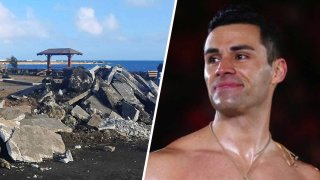
Left: Photo of damage caused by a tsunami that struck Tonga. Right: Pita Taufatofua.
Pita Taufatofua, known as the "Shirtless Tongan" carrying Tonga's flag at the Olympics, has established a GoFundMe page to help rebuild areas devastated by a tsunami following a volcanic eruption.
Taufatofua said that though the funds will be used to work on long-term projects to rebuild, they're also using funds to address immediate needs such as food and fuel.
As of Thursday evening, the "Tonga Tsunami relief by Pita Taufatofua" verified GoFundMe page has raised over $580,000 Australian dollars (over $400,000 U.S. dollars).
At least three people have been confirmed killed after the volcanic eruption 40 miles north of Tonga’s capital, Nuku’alofa, and the tsunami that followed. Several small settlements in outlying islands were wiped off the face of the map, according to the Red Cross and official reports, necessitating the evacuation of several hundred residents.
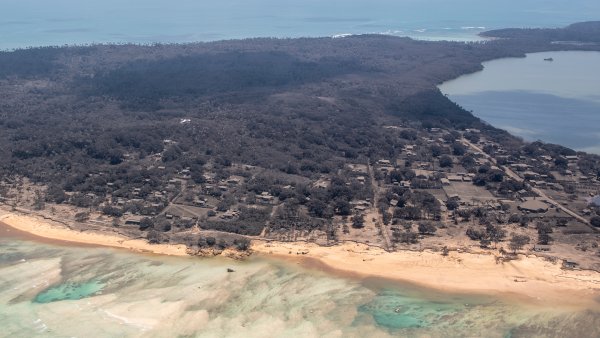
TONGAJAN 18
Despite Huge Volcano Blast, Tonga Avoids Widespread Disaster
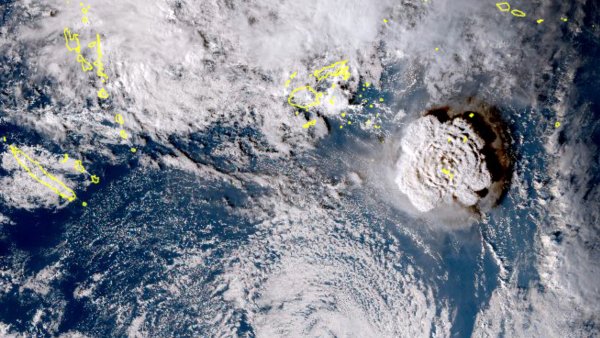
TSUNAMIJAN 15
Pacific Tsunami Threat Recedes, Volcano Ash Hinders Response
"In preparation and through the recovery efforts we are seeking your donations to help our island Kingdom," Taufatofua wrote on the page, adding that though he is training in Australia, he was mobilizing "all the assistance I can to send to our beloved Tonga."
As the massive undersea Hunga Tonga Hunga Ha’apai volcano erupted on Saturday, Tongans from around the world gazed on as their relatives live streamed images of billowing clouds of ash, gas and steam emerging from beneath the depths.
Then darkness.
The eruption severed Tonga's single fiber-optic cable, rendering the entire Pacific archipelago offline and unable to communicate with the rest of the world — and leaving their loved ones terrified about what might have happened.
“It was absolutely crazy,” said Koniseti Liutai, a Tongan who lives in Australia.
“We were talking with family and relatives, because they were excitedly showing us the volcano's activities, then we heard the explosion and the big bang and everything went dark,” he said. “Then the next information we got was the tsunami warning and then the tsunami hitting; we were all absolutely fearing the worst.”
It wasn't only family and friends who could not get through. Huge ash clouds made backup communication by satellite phone next to impossible, and world leaders were not even able to get in touch with their Tongan counterparts to see what help they needed.
As the ash cleared, satellite communication improved and Tonga's telecoms operator, Digicel, said it had been able to restore international call services to some areas late Wednesday.
With the resumption of some communications, more photos have begun to emerge of the destruction, showing the once-verdant islands turned a charcoal black by a thick coating of volcanic dust.
Coastlines are strewn with debris, while people work to clean streets and walkways.
The 2-centimeter (0.78 inch) layer of ash that rendered the runway at Fua’amotu International Airport unusable has now been cleared, and the first flights carrying fresh water and other aid arrived Thursday.
A repair ship is being sent from Papua New Guinea to work on the undersea cable, but it will take some time to get to Tonga and the company in charge estimates it could take longer than a month to repair the line.
Given that the cable runs right through the volcanic zone, any new volcanic activity could completely scupper even that timeline.
AP/NBC
Buddhist monk who brought mindfulness to West dies in Vietnam

This photo taken on November 15, 2018 shows then-92-year-old Vietnamese Buddhist monk Thich Nhat Hanh (C) in a wheelchair at the Tu Hieu pagoda in Hue (AFP/Manan VATSYAYANA)
Fri, January 21, 2022, 7:29 PM·4 min read
Vietnamese monk-turned-peace-activist Thich Nhat Hanh, a hugely influential Buddhist credited with bringing mindfulness to the West, has died aged 95.
The Zen master, whose reach within Buddhism is seen as second only to the Dalai Lama, spent nearly four decades in exile after being banished from his homeland for calling for an end to the Vietnam-American War.
Thich Nhat Hanh "passed away peacefully" at the Tu Hieu Temple in the city of Hue, Vietnam's Buddhist heartland, his Zen teaching organisation, the Plum Village Community of Engaged Buddhism, said.
"We invite our beloved global spiritual family to take a few moments to be still, to come back to our mindful breathing, as we together hold Thay in our hearts," the organisation said on Nhat Hanh's Twitter account, using the Vietnamese word for teacher.
Before his return to Vietnam in 2018, he set up retreats around the world and wrote over 100 books including on mindfulness and meditation -- a cornerstone of a $4.2 trillion global wellness industry espoused by Oprah Winfrey, Arianna Huffington and tech billionaire Marc Benioff.
- Religious freedom, peace -
Born in 1926, Thich Nhat Hanh was ordained aged 16 and went on to found a youth school which trained volunteers to build clinics and infrastructure in villages blighted by war.
In the early 1960s he travelled to the United States, where he taught at Columbia and Princeton universities, but after one trip in 1966 to meet US civil rights icon Martin Luther King -- who joined his calls to end the Vietnam-American War -- he was barred from returning home.
Believing that war was fundamentally wrong, the monk refused to take sides in the conflict and was consequently persecuted by the governments of both North and South Vietnam.
Thich Nhat Hanh spent the next 39 years in France, but continued to advocate for religious freedom around the world.
In 1967, King nominated Thich Nhat Hanh for the Nobel Peace Prize, telling the committee in a letter: "this gentle Buddhist monk from Vietnam is a scholar of immense intellectual capacity".
"His ideas for peace, if applied, would build a monument to ecumenism, to world brotherhood, to humanity."
He also continued to help his fellow Vietnamese.
As the war came to an end, many fled the country by boat, facing perilous conditions on the ocean as they attempted to reach sanctuary overseas.
Thich Nhat Hanh was able to save more than 800 people after he hired two large boats.
Such action was part of his belief in "engaged Buddhism", a term which he coined, according to John Powers, a professor of religious studies at Australia's Deakin University.
"One of the problems historically with Buddhism is that Buddhists have been really good about talking about compassion... but (they) have not been that great at putting it into practice," Powers said.
But Thich Nhat Nanh believed "it's not enough to sit on a cushion and meditate... and that's become a real cornerstone of a lot of modern Buddhism".
- Under close watch -
He was permitted by authorities to see out his final days at the Tu Hieu temple, but was closely monitored by plainclothes police who kept vigil outside his gated compound.
Since his return to Vietnam, hundreds flocked to his pagoda to join the monk on his outings around the temple's lush gardens.
Most of his followers are devoted to his spiritual messages, not his politics.
"He taught us to love people, to love ourselves, to love nature," said Tran Thi My Thanh, who made the pilgrimage to Hue with friends from Ho Chi Minh City.
His messages have not always been welcomed as authorities in Buddhist majority one-party Vietnam are wary of organised religion: in 2009 his followers were driven from their temple in southern Lam Dong province by hired mobs.
But Thich Nhat Hanh's disciples say they come in peace.
"We know that Vietnam has difficulty, and we know the world also tries to help Vietnam open up, to have more freedom, more democracy... we try to help also, but we do it in a Buddhist way," said Thich Chan Phap An, one of Thich Nhat Hanh's closest disciples.
"It's not wise to have confrontation, but it's very good to have communication," he told AFP in 2018.
caw/mdl/aph/lpm/oho
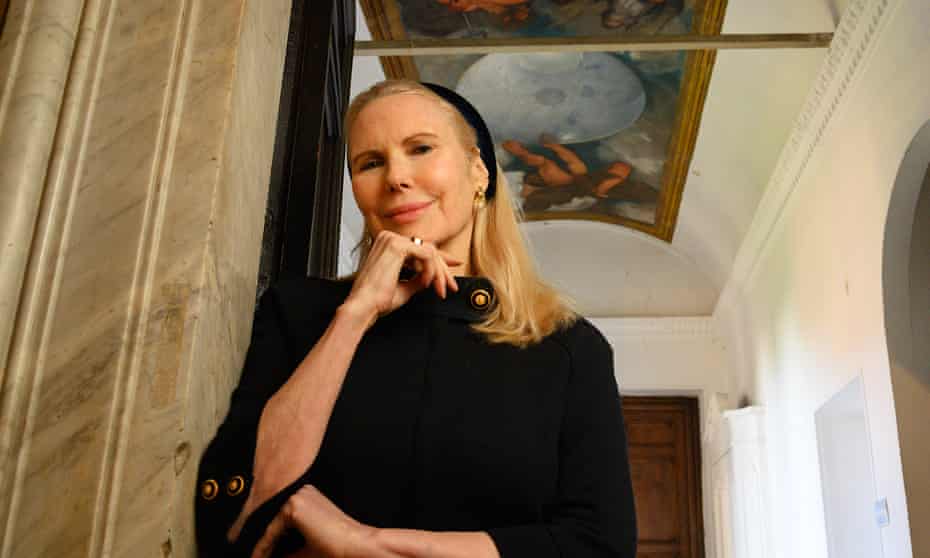
‘It’s like a museum,’ says princess caught in inheritance feud over one of the world’s most expensive homes
Angela Giuffrida in Rome
Fri 14 Jan 2022 12.31 GMT
As legend goes, tossing a coin into the Trevi fountain guarantees a return visit to Rome. When, as a 16-year-old American tourist, Rita Carpenter participated in the ritual and made a wish to one day marry a Roman and live in the Italian capital, little did she know that almost five decades on she would return to marry a prince and her home would be a 16th-century villa stuffed with history, including the only ceiling mural ever painted by Caravaggio.
But now Princess Rita Boncompagni Ludovisi is facing the prospect of having to move out of the sprawling Villa Aurora, and the vast treasures it contains are at risk of being closed off to the public.
On 18 January the property goes under the hammer, amid a bitter inheritance feud with the sons of her late husband, Prince Nicolò Boncompagni Ludovisi. Hidden by high walls close to Via Veneto in central Rome, the villa is being sold with an opening bid of €471m (£393m), which would make it one of the world’s most expensive homes.
“We couldn’t reach an agreement so the judge ruled it had to be auctioned,” said the 72-year-old. “I really haven’t slept much at all.”

The princess is sceptical a petition launched this week urging the Italian government to stump up the cash to buy the property will be successful. Since the site is protected by the ministry of culture, once a bid has been agreed at auction the state will have the chance to buy the property at the same price. “I’d like the state to buy it but I don’t know if it’s a possibility as I don’t know if they have the money, that’s the problem. And I’m not the only heir.”
The lion’s share of the asking price is attributed to Caravaggio’s Jupiter, Neptune and Pluto mural, which the artist painted in 1597 on the ceiling of a small room tucked away on the villa’s first floor. The 2.75-metre-wide mural was commissioned by the villa’s first owner, Cardinal Francesco Maria Del Monte, to adorn the ceiling of his alchemy laboratory.
But the Caravaggio is not the only slice of history that Villa Aurora’s new owner will acquire. The property lies on the site of what was once the home of Julius Caesar. Monuments in the front garden include a sculpture by Michelangelo. The building also contains ceilings frescoed by the baroque painter Guercino, who was commissioned by the Ludovisis, a noble family with close ties to the papacy who bought the property from Del Monte in 1621. The spiral staircase leading up to the Caravaggio and the three floors above was designed by the baroque architect Carlo Maderno, who also designed the facade of St Peter’s Basilica.

The 40 or so rooms are packed with relics, including a door that belonged to an ancient Venetian warship, a telescope gifted to the Ludovosi family by Galileo Galilei and a leather box inscribed with a message from the chief of the British Red Cross thanking the Ludovisi family for allowing Red Cross members to reside in the villa for two years after the second world war. Villa Aurora has hosted everyone from Tchaikovsky and Henry James, who penned some of his 1909 classic, Italian Hours, in the villa’s garden, to Bette Midler and Madonna.
“This really is a museum,” said Princess Rita.
Villa Aurora was off the radar to the public until 2010, when it opened following a restoration project inspired by the princess after she saw it for the first time in 2003, the year she met Prince Nicolò.
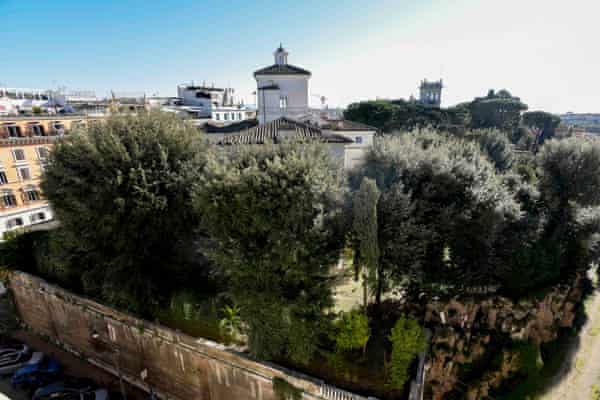
“It was abandoned, there were birds flying through it and I told Nicolò: ‘We have to open the villa, it has to be seen by Italians and other people, they need to understand the beauty and culture of it all,’” she said.
Until the prince’s death in 2018, the villa hosted students of history and small private tour groups. The couple were also behind various charity initiatives. The princess put together a digital archive of 150,000 documents that shed even more light on the history of the villa.
The princess had an intriguing life before she met Nicolò. Described by the Washington Post in 1978 as one of the four most dynamic young women in the city, she was married to the US congressman John Jenrette until their divorce in 1981 after his bribery conviction during the FBI’s Abscam investigation. She acted in several films and miniseries, studied at Harvard Business School, wrote three books and twice posed for Playboy magazine.
She was a property broker in New York when she crossed paths with Nicolò. “He’d read an article about me in Crain’s Business, and then a mutual friend got in touch and said: ‘You must come to Rome, there’s this prince who wants to put a hotel on one of his properties outside the city.’” She was initially dismissive, but eventually flew to Rome and the pair instantly fell in love. A psychic had previously told her she would marry a European and live in Europe. “I’d kind of forgotten about it, but then there he was. He was a brilliant man in every way, and the least important part about him was being a prince.”

In his will, Nicolò gave his wife the right to stay in the property for the rest of her life and, if sold, the proceeds were to be split between her and his sons. However, the sons disputed her right to stay in the villa, immediately prompting a toxic legal wrangle. She said she fears they will also try to prevent her getting her share of the sale’s proceeds.
“They want the house to themselves, forgetting how kind I’ve been to them or that their father said I made him the happiest he had been in his life. I don’t know what I’ll do afterwards, but I’ve done all I can, I can’t fight any more.”

Between October to November 2021, unvaccinated people were around 50 times more likely to die from Covid than people who were vaccinated and boosted (AFP/Frederic J. BROWN)
Fri, January 21, 2022
Covid-19 vaccines and boosters continued to have very high efficacy against severe outcomes during the Omicron wave of the virus, a large real-world study from the US Centers for Disease Control and Prevention (CDC) showed Friday.
The paper evaluated data from more than 300,000 visits to emergency departments, urgent care clinics, and hospitalizations across 10 states from August 26, 2021 to January 5, 2022.
During the period when the Delta variant was dominant, vaccine efficacy against Covid-19 hospitalization was 90 percent between 14-179 days after dose two of a vaccine, fell to 81 percent more than 180 days after the second dose, and rose to 94 percent 14 days or more after dose three.
After Omicron became dominant, the vaccine efficacy estimate against hospitalization between 14-179 days after dose two was 81 percent, 57 percent after more than 180 days from dose two, and 90 percent 14 or more days after dose three.
A second CDC paper, based on data from 25 US state and local jurisdictions, found that vaccine efficacy against infection waned from 93 percent prior to Delta to around 80 percent when Delta became dominant, but protection against death remained stable and high at 94 percent.
Vaccine efficacy against infection fell to 68 percent by the time Omicron emerged. The authors weren't able to derive an estimate for vaccine efficacy against death during Omicron, because of a lag in reporting, but the broad scientific expectation is that it will remain very high.
The paper also showed that while deaths among fully vaccinated people rose sharply during the Delta wave -- totaling more than 20,000 people between July to November -- unvaccinated people were still 16 times more likely to die during the same period.
Protection was even greater for people who were boosted. Between October to November, unvaccinated people were around 50 times more likely to die from Covid than people who were vaccinated and boosted.
ia/caw
